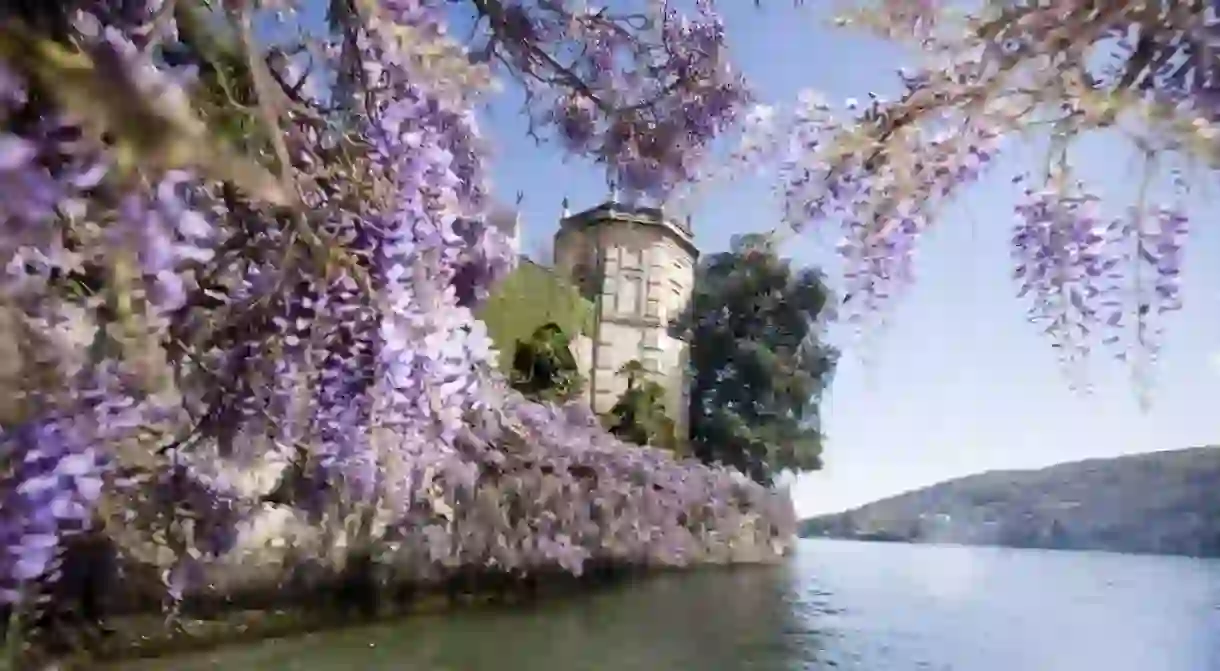The Most Stunning Castles and Palaces in Piedmont

Before Italian unification in the 19th century, the country was governed by many small principalities – the many fortified castles, palaces and vast villas found across Italy are evidence of the wealth of those dynasties and their feuding. Piedmont was home to a number of historically significant families, most notably the House of Savoy, and so the region boasts some truly majestic architecture. From turreted medieval castelli to ostentatious Baroque palazzos, read on to discover the most beautiful buildings around.
Sacra di San Michele
The ancient abbey Sacra di San Michele was built between 983 and 987 on the top of mount Pirchiriano. It is dedicated to the cult of the Archangel Michele, defender of the Christian people, and belongs to a pilgrimage route that runs all the way from Saint-Michel, France to Monte Sant’Angelo in Puglia, Southern Italy. This spiritual location has become a symbol of Piedmont and also inspired Umberto Eco’s famous 1980 monastic murder mystery novel Il Nomme della Rosa (The Name of the Rose). The mountain climate often shrouds the building in mist or clouds, adding to the drama of an already beautiful and atmospheric site.
Via alla Sacra, 14, S. Ambrogio, Italy, +39 011 93 91 30

La Venaria Reale
This magnificent Baroque estate built in the 1600s for Duke Carlo Emanuele II of Savoy, is considered ‘Turin’s Versaille’. The royal palace extends over an area of 80,000 sq. metres (861,113 sq. feet) and has extensive grounds and gardens, in which archaeological remains and 17th-century grottos are complemented by contemporary sculpture. The famous Hall of Diana designed by Amedeo di Castellamonte is a Baroque masterpiece fit for a Disney princess. The estate also runs a lively events programme from concerts to educational workshops, so be sure to check out what is on offer before your visit.
Piazza della Repubblica, 4, Venaria Reale, Italy, +39 01 14 99 23 33


Palazzo Madama
Palazzo Madama is at the heart of the historic centre of Turin and was so admired by Napoleon that he made it his Turin residence. The main palace structure dates from 1003 but the stunning façade was added by leading Baroque architect Filippo Juvarra in 1718. The rear of the castle remains in its medieval form, so it is an incredibly striking structure for this reason alone. Juvarra’s façade is a masterpiece: nine long arched windows with complex ironwork create lofty grandeur, while the clever use of light and dark stone add drama to the decorative details. The interior is perhaps even more spectacular, so much so that Juvarra’s monumental double stairway has been replicated in buildings around the world. The decoration of the first floor rooms are in a typically ostentatious Baroque style – deep rich colours are combined with heavily gilded and dramatic carvings.
Piazza Castello, Torino, Italy, +39 01 14 43 35 01

Palazzina di caccia di Stupinigi
UNESCO World Heritage Site Palazzina di caccia di Stupinigi is a gigantic hunting lodge created for the House of Savoy in the late 18th century. Once again, the complex and eccentric design is the work of Baroque architect Filippo Juvarra. The interior still holds much of the original 18th-century design – exquisite chinoiserie, ornate brocades, and lavish rococo furniture. The heart of Stupinigi is the central oval hall within the building’s vast dome, and it is stunning – light floods through the arched French doors at the bottom, small, rectangular windows half way up and large arched windows on top, and frescoes by Venetian painter Giambattista Crosato cover every single surface.
Piazza Principe Amedeo, 7, Stupinigi +39 01 13 58 12 20
Palazzo Borromeo
The small Isola Bella on majestic Lake Maggiore is home to Palazzo Borromeo, the former residence of the Borromeo family in the 17th century. Vitaliano Borromeo VI was responsible for the building of the palazzo and gardens, and today members of the Borromeo family are still involved with its upkeep. The palace is a Baroque treasure trove, in particular the lower floors which are dramatically finished in monochrome marble and functions as Vitaliano’s art wunderkammer. The gardens are also great draw – not only do you have breathtaking views of the surrounding lake and hills, but the Baroque design incorporates many elegant tiers and terrazzos dotted with sculpture. White peacocks roam the grounds in front of the eccentric Teatro Massimo.
Isola Bella, Stresa, Italy, +39 03 23 30 556


Castello di Camino
Camino Castle is considered the most beautiful castle of the Monferrato hills – Piedmont’s most castle-dense region. Dating from as early as 1000 AD, it is also renowned for its remarkable state of preservation. The dining room is in grand Neo-Gothic style and the theatre is frescoed with scenes from Don Quixote. Immersed in a park of ancient trees with views of Monferrato vineyards, it’s easy to understand why the castle was a popular destination for the Savoy family, in particular kings Vittorio Emanuelle II and III, and Umberto I.
Via Castello 30, Camino, Italy, +39 33 55 38 33 07
Castello di Rocca Grimalda
Italy’s most prized Italian writer, Alessandro Manzoni, references in one of his patriotic odes the beauty of the Valle dell’Orba, the narrow and dramatic rock on which Rocca Grimalda Castle is built. This castle is characterised by a formidable five-storey circular tower, but the real architectural draw is the trompe l’oeil chapel. There are several gardens to explore as well – there is a typical Italian garden, a lover’s garden and an cloistered orchard which still grows medieval varieties of fruit. The foundations of Rocca Grimalda Castle date from the 13th century, but the structure owes much of its grandeur to the Grimaldi family, who instigated its enlargement in the 18th century. It is also located in the Monferrato hills.
Piazza Senatore Borgatta, 2, Rocca Grimalda, Italy, +39 01 43 87 31 28














